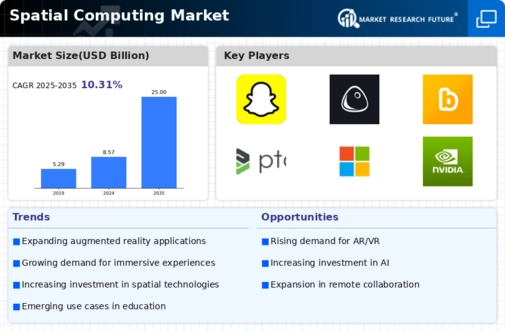Market Trends
Key Emerging Trends in the Spatial Computing Market
The spatial computing market has posted some staggering figures lately, the growth being triggered by diverse supply-side dynamics that are in direct response to the escalating demand for immersive and interactive technologies.
The use of auxiliary reality (AR) and virtual reality (VR) applications is one of the key directions, providing the emerging of the spatial computing market. MR and VR technologies are spatial computing-based employing Virtual and Augmented Reality capabilities to provide users with a chance to explore the digital world which could be layered together with the physical world or exist on its own. Thse tchnologis are rapidly grown in use by different industry areas such as gaming, entertainment, education, healthcare and retail, etc. Therefore, the rise in popularity of spatial computing has brought about creation of consumers for AR and VR technologies that facilitate the trade of their services which in turn, positively influence the market growth.
Also, the room for spatial computing as a whole is actively being expanded by the inclusion of artificial intelligence (AI) and the Internet of Things (IoT) technologies among other emerging trends. AI, IoT and spatial computing collectively bring digital and physical objects into interactivity, in the process the smart environment with many connections emerges. What is more, spatial computing is employed in 4D smart homes which are clever and have interactive purposes where the users can direct their devices by gestures and voice commands. Such growth of interest has triggered the expansion of spatial computing along with AI and IoT tools that make integration of these technologies more sophisticated and effective, thus allowing the development of more intelligent and immersive environments.
In additon to this it is evident that there is an increasing need for such spatial computing tools that are able to map and track the space around us in a very accurat and real time. The motion tracker and positioning technologies, which make the devices cognizant of the space and how they relate to the physical environment, are possible with spatial mapping and tracking technologies. These technologies are indispensable parts of AR and VR systems, which are used for virtual objects placing in the world of facts and for user movements tracking in the virtual one. The surge in favor of the trend has been linked to the desire of the companies to present more accurate and more immersive experiences through spatial computing. As a result, advanced mapping and tracking capabilities are being continuously improved by virtue of this.
Market trend in spatial computing is another that connects to spatial communication and collaboration tools. In the light of the increasing use of remote work and cooperation in the virtual domain spatial computing comes to the forefront for the development of simulation tools that ensure virtual meetings and learning collaboration in 3D environments. Spatial collaboration tools offer facilities for users to collaborate and interact with others in the same virtual space on the 2nd hand, giving workers a feeling of being involved as well as enhancing remote collaboration.


















Leave a Comment